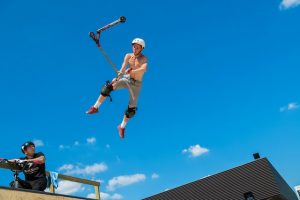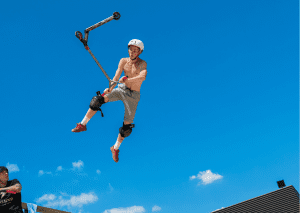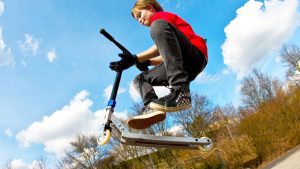We’ve all admired the skill and agility of scooter riders, effortlessly performing tricks that leave us in awe. But have you ever wondered what these stunts are called or what they involve?
In this article, FamilyHype is diving into the world of scooter trickery to decode some common maneuvers.
Scooter trick names and their meanings can vary widely, ranging from simple beginner tricks to complex and impressive maneuvers. For those just starting, beginner tricks like the tail whip, where the rider whips the scooter deck around in the air using their feet, are a great place to begin. As riders progress, they can explore more advanced stunt, such as the bar spin, where the handlebars are spun 360 degrees while airborne and then caught to continue riding.

For the daredevils, mid air stunts like the double tail whip, involving two rotations of the scooter deck, showcase a high level of skill and air awareness. Some riders even experiment with unique styles, like riding while sitting on the scooter deck, adding creativity and flair to their trick repertoire. With a vast array of maneuvers to explore, riders can continuously challenge themselves to learn new stuntsvand master the art of freestyle scooter riding.
This knowledge will heighten your appreciation for this sport and equip you with terminology if you ever wish to give it a go or support someone who does.
Each of these stunts involves a combination of agility, balance, and coordination; mastering these can take time and practice.
We encourage you to share your feedback, experience, and opinions about scooter stunts and this article. So, let’s embark on this thrilling ride together!
Key Takeaways
We will explore some of the common pro scooter tricks and their meanings here at FamilyHype, emphasizing the importance of understanding these maneuvers for an improved riding game and a deeper appreciation for the sport. Stunt scooter tricks like tailwhips, bar spins, bunny hops, backflips, heel whips, and nose manuals are all part of the scooter culture and can be performed with various difficulty levels.
No matter the difficulty level of the stunts you attempt, the connection between pro scooters and the maneuvers that can be performed on them remains the same. Whether you’re just starting or have been doing maneuvers for a while, they provide an exciting way to show off your skills. With that in mind, FamilyHype encourages you to practice and maybe even invent a few of your own!
We hope this article helps you understand the names and meanings of common stunt scooter maneuvers. Whether you’re a beginner or a seasoned pro, these maneuvers are always fun and can be a great way to show off your skills. So keep practicing and maybe invent a few of your own!
Tailwhip
The Tailwhip is undeniably one of the most iconic and impressive maneuvers in scooter riding. This gravity-defying maneuver requires the rider to perform a full 360-degree rotation of the scooter deck while in mid-air. As the rider jumps off the scooter, they use their foot to initiate the air spin, guiding the deck around their body before landing back on the scooter. The tail whip’s mesmerizing motion creates a thrilling spectacle that captures the attention of both riders and spectators.

With its rich history and roots in the freestyle scooter scene, the Tailwhip has evolved, giving rise to countless variations and combinations with other tricks. From single tailwhips to daring double tailwhips and even triple tailwhips for the most skilled riders, this trick continues to push the boundaries of what’s possible on a scooter. Its popularity lies in its technical difficulty and the sense of achievement and joy it brings to the scooter community.
Mastering the Tailwhip requires dedicated practice and a keen sense of balance and coordination. Riders must develop the right timing and footwork for smooth and controlled rotation. The trick’s challenge adds to the allure of scootering, inspiring riders to push themselves and explore the endless possibilities of creative combinations.
Barspin
Barspin is a captivating and challenging trick that has become a staple in scooter riding. The essence of the Barspin revolves around the rider’s ability to spin the scooter’s handlebars a full 360 degrees while being airborne and then skillfully catching them again to land seamlessly. This trick demands technical precision and showcases the rider’s flair and creativity in freestyle scootering.
To execute a Barspin, the rider must have a firm grip on the handlebars and generate the right momentum to initiate the spin. As they lift off the ground, they release one hand from the handlebar and flick it around to complete the rotation. Timing is crucial, as mistiming the spin can result in an incomplete rotation or even a failed attempt.

The Barspin is a favorite among scooter enthusiasts due to its stylish nature and the sense of accomplishment that comes with mastering it. Riders often incorporate Barspins into various combinations and sequences with other stunts, adding a touch of elegance to their repertoire.
Bunny Hop
The Bunny Hop is a fundamental and versatile trick with a special place in scooter riding. Unlike its adorable namesake in the animal kingdom, this trick involves much more than hopping around. The Bunny Hop requires the rider to perform a controlled jump while lifting the scooter off the ground. It is a foundational maneuver for many other advanced maneuvers and a skill that all scooter riders should master.
The origins of the Bunny Hop can be traced back to BMX biking, where it was initially developed as a technique to clear obstacles and perform jumps. Over time, scooter riders adapted and refined the Bunny Hop to suit the unique characteristics of stunt scooters, making it an essential part of their repertoire. The trick’s versatility and simplicity make it accessible to riders of all skill levels and applicable to various scooter types, from kick to electric scooters and even freestyle scooters.
Whether navigating urban terrain, hitting the skate park, or enjoying a leisurely ride, the Bunny Hop allows riders to overcome obstacles, demonstrate control over their scooter, and add flair to their scootering experience.
Backflip
The Backflip is one of the most daring and jaw-dropping stunts in scooter riding. This exhilarating maneuver involves performing a full rotation backward, flipping upside down, and then landing smoothly on the scooter. It’s a high-risk, high-reward trick that requires immense skill, courage, and confidence.
Mastering the Backflip is a significant milestone for any scooter rider, representing the pinnacle of aerial stunts. Learning the Backflip is not for the faint of heart and often involves rigorous training under the guidance of experienced coaches or professionals. Safety is paramount when attempting this trick, and riders must wear appropriate protective gear, including helmets and pads.

The Backflip has become a symbol of the freestyle and extreme side of scooter riding, captivating audiences at competitions, events, and videos online. Its execution requires a perfect blend of technique, body control, and mental focus, making it a challenge that only a few can conquer. However, for those who dare to take on the Backflip, the thrill and sense of achievement are unparalleled, pushing the boundaries of what is possible in scooter stunts.
Heel Whip
The Heel Whip is an impressive and visually captivating trick that adds flair to scooter riding. This trick involves using the rider’s heel to kick the scooter’s deck in mid-air, causing it to spin 360 degrees around the rider’s body. It is a variation of the more common Tailwhip but with the unique twist of using the heel instead of the foot’s toe.

Performing a Heel Whip requires precise timing, coordination, and balance. Riders must generate enough height and momentum to execute the whip while controlling the scooter throughout the rotation. As with any advanced trick, practicing the Heel Whip in a safe environment and wearing appropriate safety gear to minimize the risk of injury is crucial.
The Heel Whip is a favorite among scooter enthusiasts for its aesthetic appeal and the technical skill it demands. Riders often use this trick to showcase their creativity and style during competitions and freestyle events.
Nose Manual
The Nose Manual is a challenging yet thrilling trick that showcases a rider’s balance and control. In a Nose Manual, the rider balances on the scooter’s front wheel while keeping the back wheel elevated off the ground. This trick requires finesse and precision, as the rider must use subtle shifts in body weight and handlebar control to maintain the manual position on top of the wheel.
To execute a Nose Manual, the rider leans their body weight forward while lifting the back wheel off the ground. They must find the perfect balance point on the front wheel and use their body and handlebars to maintain that balance as they glide. It’s a skill that takes time and practice to master, but once accomplished, it adds a whole new dimension to a rider’s freestyle repertoire.

Nose Manuals can be performed on various surfaces, including flat ground and obstacles like ledges or rails. Advanced riders may even incorporate Nose Manuals into combinations with other tricks, showcasing their creativity and technical abilities. As with any trick, safety is paramount, and riders should wear proper protective gear all the time and practice in safe environments to minimize the risk of injuries while attempting the Nose Manual. With dedication and persistence, riders can achieve a smooth and stylish Nose Manual, impressing themselves and spectators with their finesse and mastery of this impressive trick.
Common Mistakes to Avoid
When attempting to master tricks, it’s essential to avoid common mistakes, as they can lead to potential injuries.
- Attempting Maneuvers Beyond Skill Level: Trying advanced stunts without proper training and experience can lead to accidents and injuries. Start with basic stunts and gradually progress as your skills improve.
- Neglecting Safety Gear: Failing to wear essential safety gear like helmets, knee pads, and elbow guards increases the risk of injury. Always prioritize safety and wear appropriate protective equipment.
- Lack of Regular Inspection: Not inspecting your scooter for wear and tear, such as loose bolts or damaged front wheel and back wheel, can lead to dangerous situations while performing stunts. Regularly check your scooter’s components to ensure everything is working well.
- Insufficient Warm-up: Skipping warm-up exercises before attempting stunts can strain muscles and increase the risk of muscle injuries. Warm up properly to prepare your body for the physical demands of scooter stunts.
- Poor Body Positioning: Incorrect body positioning during stunts can affect balance and control, leading to falls or collisions. Focus on maintaining proper posture and positioning for each trick.
- Ignoring Safety Guidelines: Disregarding safety guidelines and recommendations for specific maneuvers can lead to avoidable accidents. Always follow safety instructions and guidelines provided by experienced riders or trainers.
- Overconfidence: Feeling overconfident and attempting challenging riders stunts without adequate preparation can result in injuries. Stay humble and progress gradually in your trick repertoire.
- Performing Stunts in Unsuitable Locations: Choosing inappropriate locations for doing stunts, such as crowded sidewalks or uneven terrain, can increase the risk of accidents. Select safe and suitable areas for practicing and performing maneuvers.
- Lack of Focus and Distractions: Performing stunts without full concentration can lead to mistakes and potential injuries. Stay focused and avoid distractions while attempting these stunts.
- Not Seeking Professional Guidance: Trying complex stunts without guidance from experienced riders or trainers can be risky. Consider taking lessons or seeking professional advice to improve your technique and safety.
Conclusion
We’ve explored some of the common scooter tricks and their meanings here at FamilyHype, emphasizing the importance of understanding these stunts for improved riding games and a deeper appreciation for the sport.
Tricks like tailwhips, bar spins, bunny hops, backflips, heel whips, and nose manuals are all part of the scooter culture and can be performed with various difficulty levels.
The best tricks on a scooter often involve impressive skill and creativity. Riders perform 180-degree body spins while stalling on the deck, showcasing their ability to rotate their entire body while maintaining control over the scooter. These advanced maneuvers require balance, timing, and precise execution, making them stand out as some of the most exciting and challenging stunts in scooter riding.
Whether you’re just getting started or have been doing stunts for years, it’s always good to practice and maybe even invent a few of your own!
No matter the difficulty level of the tricks you attempt, the connection between trick scooters and the maneuvers that can be performed on them remains the same. Whether you’re just starting or have been doing tricks for a while, scooter tricks provide an exciting way to show off your skills.
So keep practicing and maybe invent a few of your own!
